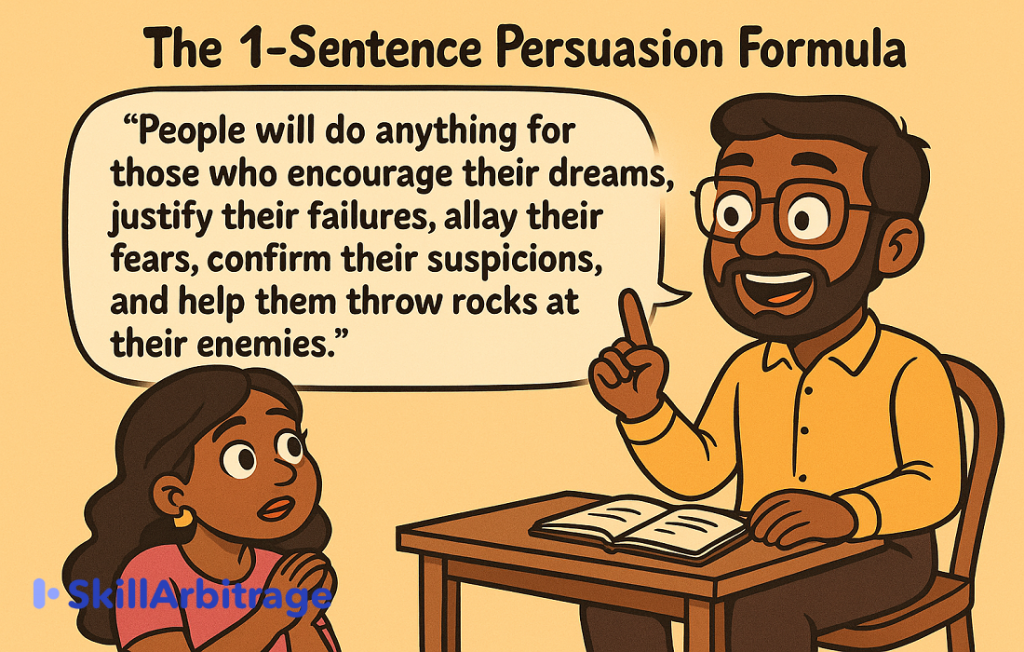This article breaks down Blair Warren’s legendary 1-Sentence Persuasion Formula, the only line that captures everything it takes to influence anyone. You will learn why it works and how to apply it to sales, storytelling, and content, and you will walk away with a tool that rewires how you earn trust and drive action.
Table of Contents
Previously in 1000 True Fans…
Parvathishankar, Raghunandan, Raja, Savitha, Harsh, and Swathi helped Bhairavi see that she didn’t need a million followers. She just needed a thousand true fans who saw her as irreplaceable. This time, he shows her how to earn that loyalty with one sharp copywriting tool: a single sentence that contains all of persuasion.
(Continued…)
Bhairavi was leaving for Pune the next morning. Her bag sat zipped up in Savitha’s living room, next to a half-finished cup of chamomile tea.
“You’ll be fine,” Savitha had said, hugging her like an older sister. “I’ll help from here.”
Then, just as Bhairavi was stepping into her cab, Savitha had added, “But before you go, spend one hour with Parvathishankar. Let him teach you the sentence.”
Bhairavi didn’t ask what sentence. She was too tired to pretend to understand.
Truth was, she was dreading the next part. Copywriting. Everyone kept telling her she had to learn it. That it would help her sell her workshops, grow her audience, and build her cult of a thousand women.
But no one could explain what it actually meant.
Bhairavi was a feminist Ayurveda practitioner. She taught urban Indian women how to read their bodies, trust their cycles, and stop outsourcing their health to systems that didn’t care about them. Her words came from lived experience and fire. Not formulas.
So when people said “learn copy,” she imagined LinkedIn bros typing threads in perfect bullet points. She thought of emails that shouted in capital letters. She thought of those soulless slogans that made her cringe.
If that was copywriting, she wasn’t sure she wanted any part of it.
Still, she took a rickshaw to Parvathishankar’s house.
He opened the door before she knocked. Handed her a steaming cup of filter coffee. Ushered her in like a doctor calling the next patient.
“Let’s make this quick,” he said, settling into his chair. “What I’m going to show you is not a trick. It’s the core of all persuasion. One sentence. That’s it.”
She blinked.
One sentence?
He smiled. “Yes. But it’s a sharp one. Ready?”
She nodded. More curious than ready.
He began.
Section 1: the sentence that sells
Parvathishankar took a sip of coffee and leaned back.
Then he said it, slowly, like he was carving the words into air.
“People will do anything for those who encourage their dreams, justify their failures, allay their fears, confirm their suspicions, and help them throw rocks at their enemies.”
Bhairavi stared at him.
“That’s… it?”
“That’s it.”
He let the silence do the heavy lifting.
“This is Blair Warren’s 1-Sentence Persuasion Course,” he said. “He’s a copywriter. Not a mainstream guru. No course funnel. No podcast. Just this sentence. And it cuts sharper than anything I’ve ever read.”
Bhairavi frowned. “So this is a copywriting trick?”
“No,” he said. “It’s the opposite of a trick. It’s how people form cults, build movements, and run revolutions. Every successful teacher, brand, politician, or messiah uses some version of this sentence. Whether they know it or not.”
She looked at her notebook but didn’t write it down.
“Break it down for me,” she said. “I don’t get how this helps me write better.”
Section 2: the anatomy of influence
“It helps you stop writing like a marketer,” he said. “Most people today are addicted to tactics. Email hacks. Viral hooks. Sales formulas. Swipe files. But those are just glitter on a hollow statue.”
He tapped the table. “This sentence is the structure inside. Five pillars. If your copy does even two or three of them, people lean in. They feel seen. If you do all five… they follow.”
Bhairavi sat up. “So this isn’t persuasion theory.”
“No,” he said. “This is cult-building in five steps.”
1. Encourage their dreams
Parvathishankar circled the first phrase.
“Encourage their dreams.”
Bhairavi raised an eyebrow. “That sounds… nice. But how’s that persuasion?”
He nodded. “Because no one else does it. Most of the world tells people to be realistic. Dial it down. Grow up. So when you say, ‘I believe in your dream,’ it hits like a thunderclap.”
He paused, then added, “That’s why Y Combinator worked. They told broke, awkward college dropouts they were the next Steve Jobs. And meant it. That belief created billion-dollar companies.”
Bhairavi exhaled. “Damn.”
Parvathishankar looked at her. “What would that sound like in your world?”
She thought for a moment.
“Maybe something like… ‘Your knowledge can free thousands of women. You’re not small. You’re early.’”
He smiled. “Exactly. That’s copy. That one line will move more women to join your workshop than a hundred reels ever could.”
She smiled back. For the first time, copywriting didn’t feel like a trick. It felt like a gift.
2. Justify their failures
Most people are carrying silent shame. They think they failed because they weren’t good enough. Persuasion doesn’t ignore that pain. It reframes it.
Weight loss ads don’t say, “You’re lazy.” They sa,y “You were lied to. The system is rigged.”
Freelancer coaches don’t say, “You suck at sales.” They sa,y “You were trained to beg, not position.”
Bhairavi frowned. “What would that sound like for someone like me?”
Parvathishankar didn’t miss a beat.
“It’s not that your workshops didn’t work. It’s that you were forced to teach in rooms that weren’t built for you.”
Bhairavi went still.
“You weren’t boring,” he said. “You were translating soul into slides. Of course, it felt off. That wasn’t failure. That was friction.”
Her eyes welled up for a second, then she smiled. “So I’m not broken.”
“You never were,” he said. “You were just teaching the right thing in the wrong frame.”
She took a deep breath. That line stayed with her. The shame didn’t vanish. But it loosened its grip.
3. Allay their fears
Fear kills action. The brain stalls when it senses risk. Great copy doesn’t hype the dream alone. It whispers, “You’ll be safe.”
Apple didn’t sell specs. It said, “It just works.” No crashes. No viruses. No panic.
Parvathishankar leaned forward. “What are your women afraid of?”
Bhairavi didn’t hesitate. “Being judged. Being wrong. Saying something and getting shut down by a doctor in a coat.”
He nodded. “Then give them this: ‘You don’t have to debate your doctor. Just learn the language of your body.’”
Bhairavi whispered it back to herself.
“Not a fight,” she said. “Just fluency.”
“Exactly,” said Parvathishankar. “Fear says: shut up and obey. Your copy should say: you already know. You just need the words.”
Something shifted in her posture. Less defense. More clarity.
4. Confirm their suspicions
People don’t want balanced arguments. They want their gut feelings validated.
“Big Food doesn’t care about your health.”
You read that, and you nod. Not because it’s a revelation. But because you already believed it. The copy just gave you permission to say it out loud.
Parvathishankar asked, “What do your women already suspect?”
Bhairavi’s face hardened. “That mainstream wellness isn’t really for them. It’s built for rich, white, cis women. That their pain is either exoticized or ignored.”
He held her gaze. “Say that.”
She scribbled something. Looked up. “Maybe… ‘You’re not too sensitive. The system was never built for your body.’”
Parvathishankar smiled. “Now they know you’re on their side.”
Because suspicion is fuel. And good copy doesn’t smother it with reason. It gives it shape.
5. Help them throw rocks at their enemies
Last step. The gloves come off.
“Persuasion ends when solidarity begins,” Parvathishankar said. “And nothing unites like a common enemy.”
Basecamp built a tribe by saying no to 80-hour workweeks, no to funding madness, and no to tech-bro grind culture. They didn’t just offer software. They offered rebellion.
Bhairavi thought for a moment. “Who are we throwing rocks at?”
Parvathishankar didn’t blink. “Anyone who told your women they were hysterical. That their pain was imaginary. That their bloating was all in their heads.”
Bhairavi clenched her jaw. “So I can say… ‘You’re not overreacting. You’ve been gaslit by generations of men in coats.’”
He nodded. “Now it’s not just education. It’s revolution.”
When your audience sees a villain, they become the hero.
And when you hand them a rock, they’ll follow you to war.
Section 3: from Sentence to System
Bhairavi stared at her notebook. Five short lines. That was it.
Encourage their dreams.
Justify their failures.
Allay their fears.
Confirm their suspicions.
Help them throw rocks at their enemies.
“This isn’t just a sentence,” Parvathishankar said, sipping his coffee. “It’s a system. If you embed these five elements into everything you write, you won’t need to ‘sell’ again. People will just get it.”
Bhairavi looked skeptical. “You mean I can write one sentence and magically women will join my workshops?”
“No,” he said. “You write a hundred things. But they all carry the same emotional signature. That’s what builds a cult. You use this sentence to guide what you say everywhere.”
He took her phone and opened her website.
“Your ‘About’ page. Right now, it says you’re a wellness educator. That’s generic. Rewrite it to encourage their dreams. Say what they secretly want: to feel at home in their own body.”
She nodded slowly.
“Now your product copy,” he continued. “Your workshop descriptions. Instead of listing modules, speak to their failures. How they’ve been dismissed, misdiagnosed, and told their pain is normal. Tell them it’s not their fault.”
He opened her Instagram. “Your posts can allay their fears. Make them feel safe. Like, they’re not crazy for asking questions. Like their body is not a problem to be fixed.”
“And this,” he said, holding up one of her reels, “this is where you confirm their suspicions. Say what they’ve always suspected but no one says out loud: most wellness advice wasn’t made for women like them.”
Finally, he looked her in the eye. “And don’t forget to throw rocks. You’re not just teaching Ayurveda. You’re reclaiming it from the gatekeepers. Say it. Loudly.”
Bhairavi sat back, a little breathless.
It wasn’t about learning to write like a marketer.
It was about saying what her people needed to hear in places they already looked.
One sentence. Repeated everywhere.
That’s how movements are built.
Section 4: using AI to tell your truth
Parvathishankar smiled as Bhairavi took a sip of coffee. “You’ve got the sentence. Now let me show you how AI can help you make it real, fast.”
Bhairavi raised an eyebrow. “AI? I’m not a tech person.”
“Doesn’t matter,” he said. “AI is just a tool. You feed it the one sentence, and it helps you craft emails, posts, workshop invites, and even sales pages, all built around that sentence.”
He opened his laptop. “Watch this.”
He typed:
Write an Instagram post for a feminist Ayurveda teacher who encourages women’s dreams, justifies their struggles, allays their fears, confirms their suspicions, and helps them challenge the system that ignores their bodies. Make it warm, authentic, and persuasive.
Within seconds, a draft appeared. It wasn’t perfect, but the core message was clear, woven throughout.
Parvathishankar explained how Bhairavi could shape that draft with her own voice and stories.
“Think of AI as your copy assistant,” he said. “It doesn’t replace your truth. It just turns your one sentence into many messages, so you never get stuck.”
Bhairavi nodded, feeling the knot in her chest loosen. AI wasn’t magic. It was a way to amplify the message she’d been scared to share.
“Now you have the sentence, the system, and the tool,” Parvathishankar said. “You’re ready to build your cult.”
Section 5: what only you can say
Parvathishankar leaned forward.
“Anyone can copy this sentence,” he said. “They’ll throw it into sales pages, webinars, and ads. But if it doesn’t come from truth, it won’t work.”
Bhairavi frowned. “So I can’t just learn the moves?”
“You can. But people will feel the gap. If you don’t believe it, they won’t either.”
He tapped her notebook. “This sentence is only powerful if it reflects what you would die defending. Not what’s trending. Not what converts. What matters to you.”
Bhairavi was quiet.
She thought of her college professor who mocked her for studying menstrual rituals. She thought of the doctor who told her painful cramps were “just part of being a woman.” She thought of the influencer who packaged her culture into pink powders and yoga mats.
Her hands tightened around her pen.
“That’s your edge,” Parvathishankar said. “Your rage is the message.”
She looked up.
“If you want women to follow you, show them who you’re fighting. Not vaguely. Name it. Systems. Institutions. Gurus. Algorithms. Whoever it is.”
Bhairavi smiled, just slightly.
“I think I know what to say now.”
“Good,” he said. “Now go say it everywhere.”
(To be continued…)







 Allow notifications
Allow notifications
